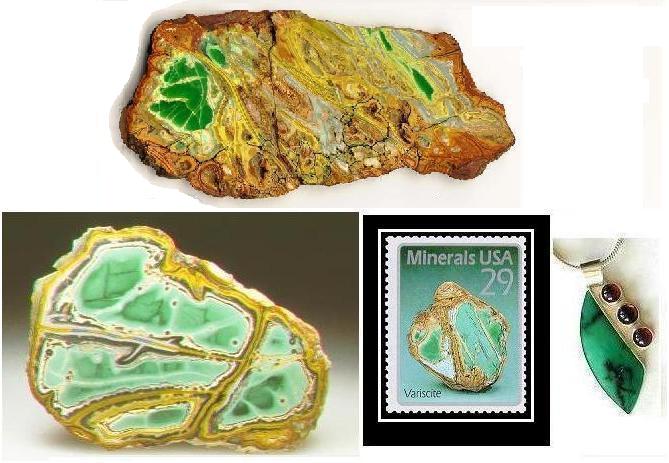( Fr- variscite; Ger- Varisit;
Nor- varisitt; Rus- ![]() )
)
VARISCITE, AlPO4·2H2O.

A. Variscite nodule (width - 13.7 cm) from Clay Canyon, near Fairfield, Utah. Dark green is variscite; yellowish is crandallite; greyish is wardite + millisite; rusty is limonite; ... (R.W. Thomssen, personal communication, 2003). (© photo by Dana Wilson,M.D.)
B. Variscite nodule (width - 15.3 cm) from Clay Canyon, near Fairfield, Utah. Light green and white are variscite; yellow is crandallite; ... (R.W. Thomssen, personal communication, 2003). Martin Zinn collection. (© photo by Jeffrey A. Scovil)
C. Variscite nodule in the Smithsonian Institution collections shown as one of the four specimens on the "Minerals USA" block of twenty-nine cent ($.29) postage stamps issued in 1992 (© photo of stamp by Richard Busch, http://mineralstamps.rbnet.net)
D. Variscite pendant, including three garnets (height - 4.1 cm). (© photo by Jan McClellan, www.designjewel.com)
DESCRIPTION: Compact, massive variety, which typically consists
largely of variscite but commonly includes other minerals (see REMARKS)
and/or rock materials. Properties of variscite follow:
Colors - off-white, buff, gray, yellow,
green, brown, pink with several shades of green with yellow-green to
bluish green the most common, with the colors of individual nodules
ranging from virtually one solid color to all sorts of arrangements of
diverse hues -- e.g., "eyes," weblike patterns, and swirls
H. 3½ -4½
S.G. 2.3 - 2.6
Light transmission - translucent to opaque
Luster - dull,
pearly or waxy
Miscellany -
splintery to conchoidal fracture; flakes turn purple when put on
warm electric stove coils.
OTHER NAMES:
USES: Cabochons, carvings and polished slices used as ornaments.
OCCURRENCES: A secondary mineral deposited in near-surface loci where phosphate minerals and clay minerals are present. It occurs as irregularly shaped ("bulbous") nodules (up to 40 cm in greatest dimension), as "veins" and coatings on fragments in, for example, fault zone breccias and gouge, and in unconsolidated deposits derived from these rocks.
NOTEWORTHY LOCALITIES: At Pannece', Loire-Atlantique, France; near Freiberg, Karl-Marx Stadt, Germany; near Crescent Valley, Lander County and Ely, White Pine County, Nevada; Clay Canyon, near Fairfield, Utah County and at the Amatric mine, Toole County, Utah. See also localities noted under OTHER NAMES subheading. Other, more recently recorded localities are the meekatharra District in Western Australia and "reportedly from the vicinity of Yauli... ~200 km southeast of Lima [Peru]" ( Hyršl, 2011a). The latter, which occurs as veins, is light green to grayish (ibid).
REMARKS: Variscite is named for Variscia, the ancient Latin name for Vogtland, the locality where it was first discovered. The type locality is Messbach (near Plauen), Vogtland, Thuringen, Germany , which is in the famous Erzgebirge (Ore mountains).
Two particular things should be kept in mind when sawing and polishing variscite rough: 1.sawing should not be done using oil because variscite and some of the other minerals in the typical nodules absorb and become discolored with oils; 2.polishing, for example, nodules to a flat surface may be difficult because the variscite and other mineral constituents have different hardnesses and/ordifferent degrees of compactness even within individual nodules. Indeed, several cautions need to be taken into account so far as, for example, cleaning any variscite that has not been treated: Do NOT use an ultrasonic cleaner, common cleaning agents or other chemicals (e.g., alcohol or acetone), steam, or even hot water; use only soft clean absorbent cloth to clean it; leave it on a dry absorbent cloth until it is completely dry; [and] never let it soak in water of any temperature.
Some carvers of variscite matrix material have fashioned their works so the matrix material greatly enhances or actually provides part of the character of the resulting figures.
Carnahan (1960) describes 13 phosphate minerals that commonly occur with variscite in variscite nodules -- they are, listed alphabetically, crandallite, davidsonite, dehrnite, deltaite, englishite, gordonite, lehiitie, lewistonite, millisite, montgomeryite, overite, sterrettite, and wardite. As later noted by Hemrich (1963), who again lists the same minerals, "Many of them occur in a single specimen, making almost every variscite nodule a compact collection of rare phosphates." Thomssen (1991) lists goyazite and kolbeckite, as well as more common minerals such as calcite, quartz, and alunite as constituents of Utah variscite nodules, and notes that dernite and lewistonite have been shown to be carbonate-fluorapatite and davidsonite and lehiite have been discredited.
SIMULANTS: Although variscite is sometimes confused with chrysocolla, chrysoprase, and green turquoise, to my knowledge, none of these has been represented as variscite.
***Reconstructed variscite - variscite sintered in the same way that turquoise is to produce reconstructed turquoise (see TURQUOISE entry). - [Appearance suffices.].
***Synthetic variscite - I have found this listed but nothing about it. [???].
Vashegyite - a variety of this mineral from Nevada has been fashioned into articles marketed as variscite matrix. - [Both hardness (H. 2-3) and specific gravity (S.G. ~ 1.96) are less than those for variscite.].
REFERENCES: Thomssen,1991.
R. V. Dietrich © 2015
Last
update: 12 February 2011
web page created by Emmett Mason